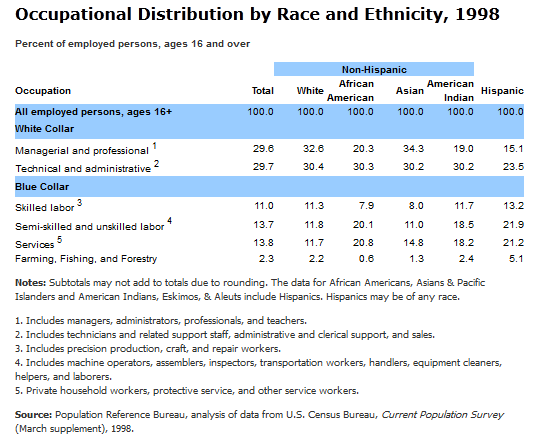
U.S. Occupational Segregation
Date
February 1, 2000
Author
(February 2000) Hispanics, African Americans, and American Indians are more likely than non-Hispanic whites or Asians to work in lower-paying, semi-skilled jobs or as service workers. They are less likely to hold white-collar jobs, which range from managerial and professional to clerical positions. Blacks, Hispanics, and American Indians who do hold white-collar jobs are more likely than whites or Asians to work as typists, clerks, or salespeople rather than as higher-earning managers or professionals. And, while the share of U.S. workers in farming, fishing, or forestry is quite small, it is greatest among Hispanics, reflecting the large number of Hispanics who work in agriculture.

One of the few higher-earning occupations in which blacks and Hispanics are well represented is professional sports. In 1997-1998, over three-fourths of players in the National Basketball Association (NBA) and two-thirds of players in the National Football League (NFL) were black. Of the major professional sports, Major League Baseball (MLB) and Major League Soccer (MLS) include the most diverse groups of players. Over 20 percent of the players in MLB and MLS are Hispanic, and at least 15 percent are black. The National Hockey League is the only major professional sports league that remains almost exclusively white.
Citations
Data on occupational segregation are based on tabulations from the Census Bureau’s March Current Population Survey (CPS).
Statistics on minorities in professional sports are available from the Center for the Study of Sports in Society. “1998 Racial and Gender Report Card,” accessed online at www.nuway.neu.edu/sport/ in September 1999.
